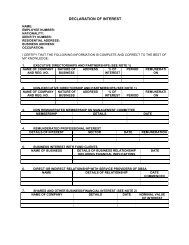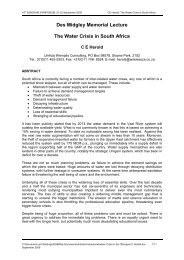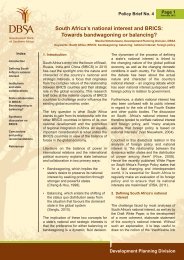A Knowledge Strategy
A Knowledge Strategy
A Knowledge Strategy
You also want an ePaper? Increase the reach of your titles
YUMPU automatically turns print PDFs into web optimized ePapers that Google loves.
Figure 5: Enterprise ICT architecture framework<br />
Strategic framework<br />
(business model and strategies)<br />
DBSA business process model<br />
Information technology architecture<br />
Data architecture<br />
Application architecture<br />
Infrastructure architecture<br />
At present, the Bank has completed the first logical iteration of its enterprise<br />
architecture in the form of the current or ‘as-is’ architecture. As we now unpack<br />
the Vision 2010 and determine what this will require in terms of client needs,<br />
products and services, any new or refined business processes and systems, we will<br />
begin to evolve the ‘to-be’ architecture and supporting delivery strategy.<br />
Now that the focus is on the data architecture, the Bank is starting to see the<br />
shift in focus of the ICT strategy towards decision support and knowledge-related<br />
systems. The development of the single source data repository is a critical element<br />
in the strategy going forward and most of the new information system will point<br />
towards this repository or virtual data warehouse as the primary source of<br />
information. This presents the opportunity to begin to mine this data asset from<br />
the point of view of business intelligence or customer relationships or simply as an<br />
analytical tool. Figure 6 shows the organisational hierarchy and appropriateness of<br />
the various types of tools to levels in an organisation.<br />
The data repository also provides the opportunity to integrate some of the<br />
other non-transactional data assets such as socio-economic statistics and time<br />
series into the pool of information at the disposal of the new information systems<br />
and tools. A word of caution needs to be expressed in that with the consolidation<br />
of all the data assets and the sheer size of the resultant data repository we need to<br />
be careful not to create new problems such as information overload or create data<br />
navigation problems. The experience of some earlier data warehouse technologies<br />
46 Development Bank of Southern Africa

















